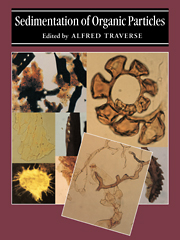Book contents
- Frontmatter
- Contents
- Editor's preface
- List of contributors
- I Introduction
- II Studies of palynosedimentation in modern environments
- 2 The sorting of spores and pollen by water: experimental and field evidence
- 3 Transport and deposition of pollen in an estuary: signature of the landscape
- 4 Pollen preservation in alkaline soils of the American Southwest
- 5 Wind and water transport and sedimentation of miospores along two rivers subject to major floods and entering the Mediterranean Sea at Calvi (Corsica, France)
- 6 Sedimentation of land-derived palynomorphs in the Trinity–Galveston Bay area, Texas
- 7 The genesis and sedimentation of phytoclasts with examples from coastal environments
- 8 Palynofacies of some recent marine sediments: the role of transportation
- 9 Maceral palynofacies of the Louisiana deltaic plain in terms of organic constituents and hydrocarbon potential
- 10 Organic sedimentation in a carbonate region
- 11 An approach to a standard terminology for palynodebris
- 12 Relationships of palynofacies to coal-depositional environments in the upper Paleocene of the Gulf Coast Basin, Texas, and the Powder River Basin, Montana and Wyoming
- III Reconstruction of late Cenozoic vegetation and sedimentary environments from palynological data
- IV Application of data on palynosedimentation to solution of geological problems
- V Appendix
- Index
7 - The genesis and sedimentation of phytoclasts with examples from coastal environments
Published online by Cambridge University Press: 06 January 2010
- Frontmatter
- Contents
- Editor's preface
- List of contributors
- I Introduction
- II Studies of palynosedimentation in modern environments
- 2 The sorting of spores and pollen by water: experimental and field evidence
- 3 Transport and deposition of pollen in an estuary: signature of the landscape
- 4 Pollen preservation in alkaline soils of the American Southwest
- 5 Wind and water transport and sedimentation of miospores along two rivers subject to major floods and entering the Mediterranean Sea at Calvi (Corsica, France)
- 6 Sedimentation of land-derived palynomorphs in the Trinity–Galveston Bay area, Texas
- 7 The genesis and sedimentation of phytoclasts with examples from coastal environments
- 8 Palynofacies of some recent marine sediments: the role of transportation
- 9 Maceral palynofacies of the Louisiana deltaic plain in terms of organic constituents and hydrocarbon potential
- 10 Organic sedimentation in a carbonate region
- 11 An approach to a standard terminology for palynodebris
- 12 Relationships of palynofacies to coal-depositional environments in the upper Paleocene of the Gulf Coast Basin, Texas, and the Powder River Basin, Montana and Wyoming
- III Reconstruction of late Cenozoic vegetation and sedimentary environments from palynological data
- IV Application of data on palynosedimentation to solution of geological problems
- V Appendix
- Index
Summary
Introduction
Significant quantities of biomass are produced yearly by vegetation in terrestrial communities. The fate of the majority of these plants is to be recycled through biodeterioration and soil-forming processes. A small quantity of all biomass generated is introduced into depositional environments. There it may be subjected to a complexity of preservational mechanisms, the results of which may be the development of identifiable fossil materials. In many instances, though, the plant parts are not preserved in their entirety. The number of fossil plant assemblages (phytocoenoses) that contain exquisitely preserved elements is low when compared to those assemblages in which ‘unidentifiable’ detritus litters bedding surfaces. In this latter case, select plant elements, predisposed to resist biodegradation, are mechanically fragmented by physical processes operating in the specific depositional environment into which the plant parts were introduced. These meso (2 mm–200 μm) and microtaphocoenoses (<200 μm sensu Krassilov, 1975) composed of phytoclasts (sensu Cope, 1980) generally are overlooked by workers whose research is focused on macrotaphocoenoses. The potential data-set inherent in the nannodetrital assemblage may provide new and/or complementary information not generally available in macrofossil assemblages (see Tiffhey, 1989). Palynologists, on the other hand, often analyze this data set because this particulate organic detritus is recognized as residue from palynological preparations. Based on the physical characters of this residue, recovered plant parts may be placed into either of two broadly transcribed categories, structured or amorphous organic material. Organic geochemists, on the other hand, commonly lump all these elements into the generalized term, Organic Matter (OM; see Hue, 1988), which has been shown to be comprised of various chemical structures as reflected in their pyrolysis-gas chromatography patterns (Hue et al., 1985).
- Type
- Chapter
- Information
- Sedimentation of Organic Particles , pp. 103 - 128Publisher: Cambridge University PressPrint publication year: 1994
- 25
- Cited by

